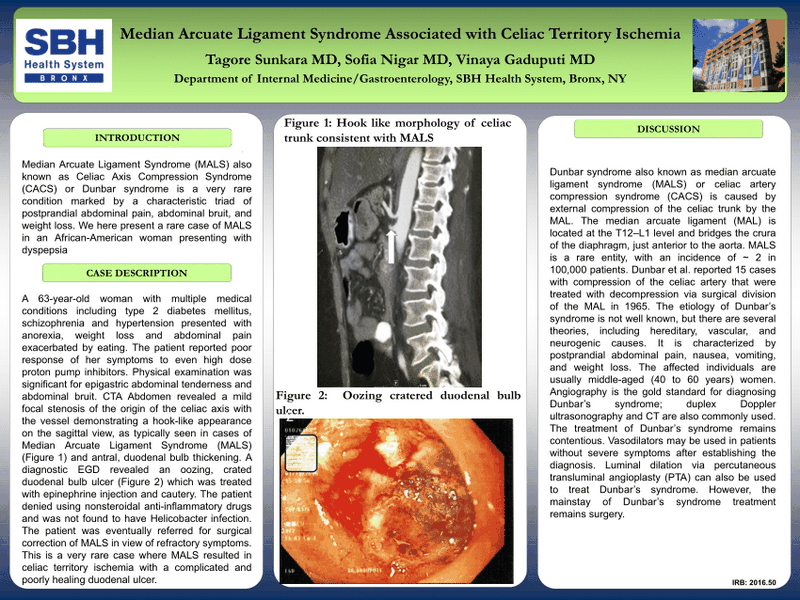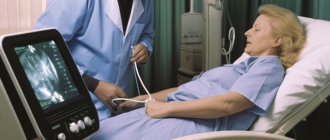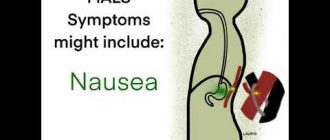What is MALS? An Introduction to Median Arcuate Ligament Syndrome.
What is MALS?

Median Arcuate Ligament Syndrome (MALS) is a rare condition that affects the median arcuate ligament, a band of tissue that connects the diaphragm to the spine. This ligament sits just above the median nerve, which runs through the forearm, and when it becomes too tight or compressed, it can cause a variety of symptoms.
Understanding the Median Arcuate Ligament
The median arcuate ligament is an important part of the anatomy of the abdomen. It helps to support the diaphragm and stabilize the spine. However, in some cases, the ligament can become too tight or fibrous, causing it to compress the median nerve. This can lead to pain, numbness, and other symptoms, which are collectively known as Median Arcuate Ligament Syndrome (MALS).
Symptoms and Diagnosis
MALS can cause a range of symptoms, including abdominal pain, digestive issues, weight loss, and fatigue. These symptoms can vary in severity from person to person, and they may worsen after eating. While the cause of MALS is still not fully understood, it is thought to be related to a combination of factors, including genetics and nerve dysfunction.
Treatment Options
There are several treatment options available for MALS, depending on the severity of the symptoms. In some cases, lifestyle changes, such as dietary modifications and stress reduction, may be enough to manage the condition. In more severe cases, surgical intervention may be necessary to alleviate the compression of the median nerve. These surgeries may involve removing or repositioning the median arcuate ligament, or widening the space around the ligament to relieve pressure.
Conclusion
Median Arcuate Ligament Syndrome is a rare condition that can cause a range of symptoms. Understanding the anatomy and function of the median arcuate ligament is crucial in diagnosing and treating MALS. If you are experiencing symptoms such as abdominal pain or digestive issues, it is important to consult with a healthcare professional to determine the best course of treatment for you.
An Overview of Median Arcuate Ligament Syndrome (MALS)
MALS, also known as Median Arcuate Ligament Syndrome, is a rare disorder that affects the median arcuate ligament, which is a fibrous band of tissue in the abdomen. It is characterized by the compression of the celiac artery by the median arcuate ligament, leading to abdominal pain and other symptoms.
The median arcuate ligament is located just below the diaphragm and connects the left and right crura of the diaphragm. In some individuals, the ligament may be positioned lower than normal or may be abnormally thick, causing it to compress the celiac artery. This compression can restrict blood flow to the organs supplied by the celiac artery, leading to symptoms.
What causes MALS is not completely understood. It is believed to be a result of a combination of structural and functional factors. Some studies suggest that the syndrome may be more common in individuals with certain anatomical variations, such as a low-lying diaphragm or a narrow celiac artery.
The main symptom of MALS is chronic abdominal pain, which is typically located in the upper abdomen and may be worsened by eating or physical activity. Other symptoms may include weight loss, nausea, vomiting, and diarrhea. Because these symptoms can be vague and overlap with other conditions, MALS is often misdiagnosed or underdiagnosed.
Diagnosis of MALS typically involves a thorough medical history, physical examination, and imaging tests. The most commonly used imaging test is computed tomography (CT) angiography, which can visualize the celiac artery and determine if there is any compression.
Treatment options for MALS depend on the severity of symptoms and the degree of celiac artery compression. Conservative measures, such as dietary changes and medication, may be initially recommended to manage symptoms. However, if symptoms are severe and persistent, surgical intervention may be necessary. The goal of surgery is to release the compression of the celiac artery and restore proper blood flow.
In conclusion, MALS is a rare syndrome characterized by the compression of the celiac artery by the median arcuate ligament, leading to chronic abdominal pain and other symptoms. It is often misdiagnosed or underdiagnosed, but advancements in imaging technology have improved its diagnosis. Treatment options vary depending on the severity of symptoms, with surgery being an option for severe cases.
What is MALS?
MALS stands for Median Arcuate Ligament Syndrome. It is a rare syndrome that occurs when the median arcuate ligament, a fibrous band of tissue in the abdomen, presses on the celiac artery, leading to a range of symptoms. MALS is also known as Celiac Artery Compression Syndrome.
When the median arcuate ligament presses on the celiac artery, it can cause a narrowing or blockage of the artery, leading to reduced blood flow to the organs supplied by the artery, such as the stomach, liver, and spleen. This can result in symptoms such as chronic abdominal pain, weight loss, nausea, and vomiting.
MALS is a complex condition that can be challenging to diagnose, as its symptoms can mimic other gastrointestinal disorders. It is often diagnosed through a combination of medical history, physical examination, imaging tests, and sometimes, invasive procedures.
Treatment for MALS usually involves surgical intervention to release or remove the median arcuate ligament, relieving the compression on the celiac artery and restoring blood flow to the organs. However, the decision to undergo surgery is individualized, and the potential risks and benefits should be carefully weighed.
Overall, understanding MALS is essential for accurately diagnosing and managing this syndrome. Ongoing research is being conducted to improve the understanding of MALS and develop more effective treatment approaches.
Causes of MALS
Median Arcuate Ligament Syndrome (MALS) is a rare condition that affects the median arcuate ligament, a ligament that runs across the aorta and the diaphragm. This ligament can sometimes compress the celiac artery, leading to symptoms and complications. The exact cause of MALS is not well understood, but there are several factors that may contribute to its development.
- Anatomy: Some individuals may have an anatomical variation in the position or shape of the median arcuate ligament, which can increase the likelihood of compression of the celiac artery.
- Genetics: There may be a genetic component to MALS, as it sometimes runs in families. However, the specific genes involved have not been identified.
- Trauma: In some cases, MALS may be caused by trauma to the abdomen or chest, such as a car accident or a fall. This trauma can disrupt the position or function of the median arcuate ligament, leading to compression of the celiac artery.
- Inflammation: It is believed that inflammation in the surrounding tissues of the celiac artery may contribute to the development of MALS. This inflammation can cause the tissues to swell, leading to compression of the artery.
While these factors may increase the risk of developing MALS, it is important to note that not everyone with these risk factors will develop the syndrome. MALS is a complex condition, and further research is needed to fully understand its causes.
Symptoms and Diagnosis of MALS
MALS, or Median Arcuate Ligament Syndrome, is a rare condition that affects the median arcuate ligament, a band of tissue that connects the diaphragm and the spine. It is important to understand the symptoms and diagnosis of MALS in order to provide proper treatment and management for individuals with this syndrome.
What are the symptoms of MALS?
- Abdominal pain: One of the primary symptoms of MALS is chronic abdominal pain, which is typically described as a dull or cramping pain in the upper abdomen. The pain may worsen after eating or during physical activity.
- Weight loss: Many individuals with MALS experience unexplained weight loss, which can be attributed to decreased appetite and difficulty eating due to the abdominal pain.
- Nausea and vomiting: MALS can cause persistent nausea and vomiting, especially after meals.
- Diarrhea: Some individuals with MALS may have frequent episodes of diarrhea.
- Other symptoms: Other less common symptoms of MALS may include bloating, early satiety (feeling full after eating a small amount), and heartburn.
How is MALS diagnosed?
Diagnosing MALS can be challenging due to the rarity of the condition and the similarity of its symptoms to those of other gastrointestinal disorders. However, there are several diagnostic tests that can help confirm the presence of MALS:
- Medical history and physical examination: Your healthcare provider will ask about your symptoms and medical history, and perform a physical examination to assess for any signs of MALS.
- Imaging tests: Imaging tests, such as ultrasound, computed tomography (CT) scan, or magnetic resonance imaging (MRI), can provide detailed images of the median arcuate ligament and surrounding structures to determine if there is any compression of the celiac artery.
- Blood tests: Blood tests may be performed to rule out other conditions that may cause similar symptoms.
It is important to consult with a healthcare professional if you are experiencing symptoms that may be indicative of MALS. They can provide a proper diagnosis and recommend appropriate treatment options.
Treatment Options for MALS
Median Arcuate Ligament Syndrome (MALS) is a condition where the median arcuate ligament compresses the celiac artery, leading to symptoms such as abdominal pain and weight loss. It is important to assess the severity of the syndrome before considering treatment options.
1. Conservative Management:
- For mild cases of MALS, conservative management may be recommended.
- Conservative management involves lifestyle changes and medications to alleviate symptoms.
- This may include changes in diet, exercise, and the use of pain medications.
2. Interventional Radiology:
- In cases where conservative management is ineffective, interventional radiology procedures may be considered.
- Angioplasty and stenting can be performed to widen the celiac artery and improve blood flow.
- This procedure is minimally invasive and is done under local anesthesia.
3. Surgical Interventions:
- In more severe cases, surgical interventions may be necessary.
- Laparoscopic median arcuate ligament release is a common surgical procedure performed for MALS.
- This procedure involves cutting or releasing the median arcuate ligament to relieve the pressure on the celiac artery.
4. Post-Surgical Care:
- Following surgical interventions, patients will need to undergo post-surgical care to ensure proper healing and recovery.
- This may include pain management, wound care, and follow-up appointments with the healthcare provider.
- Physical therapy may also be recommended to regain strength and mobility.
5. Lifestyle Modifications:
- In addition to medical interventions, certain lifestyle modifications can help manage MALS.
- These may include maintaining a healthy diet, regular exercise, and stress reduction techniques.
- Working with a dietitian and healthcare provider can help create a personalized plan for managing symptoms.
It is important for individuals with MALS to work closely with their healthcare provider to determine the most appropriate treatment options based on their specific condition and symptoms.
Non-Surgical Treatments for MALS
In the previous section, we discussed what Median Arcuate Ligament Syndrome (MALS) is and provided an introduction to this condition. Now, let’s explore some of the non-surgical treatment options available for MALS.
1. Medications:
- Pain Medication: Over-the-counter pain relievers, such as ibuprofen or acetaminophen, can help manage the abdominal pain associated with MALS.
- Antidepressants: Certain antidepressants can be used to help manage chronic pain and improve mood in individuals with MALS.
- Antispasmodic Medication: Medications that relax the muscles in the abdomen can be prescribed to help relieve symptoms.
2. Dietary Changes:
- Low-Fat Diet: Following a low-fat diet can help reduce symptoms, as high-fat foods can trigger pain and discomfort in MALS patients.
- Small, Frequent Meals: Eating smaller meals throughout the day can help prevent excessive pressure on the median arcuate ligament and alleviate symptoms.
- Avoiding Trigger Foods: Some individuals may find that certain foods, such as spicy or greasy foods, worsen their symptoms. It’s important to identify and avoid these trigger foods.
3. Physical Therapy:
- Core Strengthening Exercises: Engaging in specific exercises that target the core muscles can help improve posture and alleviate pressure on the median arcuate ligament.
- Stretching: Stretching exercises can help improve flexibility and relieve muscle tension in the abdomen, reducing pain and discomfort.
- Breathing Techniques: Learning and practicing deep breathing exercises can help relax the abdominal muscles and manage pain.
4. Nerve Blocks:
- Celiac Plexus Block: This procedure involves injecting medication into the nerves surrounding the celiac plexus, which can provide temporary relief from abdominal pain.
- Neurolysis: In some cases, a neurolysis procedure may be performed to permanently damage the nerves in the celiac plexus, providing long-lasting pain relief.
It is important to note that these non-surgical treatments may not completely cure MALS, but they can help manage symptoms and improve quality of life for individuals living with this condition.
Surgical Treatments for MALS
When it comes to treating Median Arcuate Ligament Syndrome (MALS), surgery is often necessary to alleviate the symptoms and improve the patient’s quality of life. There are several surgical treatments available, each with its own benefits and considerations.
One common surgical procedure for treating MALS is called the median arcuate ligament release. In this procedure, the surgeon releases the fibrous band of tissue known as the median arcuate ligament, which is often compressing the celiac artery and causing symptoms. By releasing this ligament, blood flow to the abdominal organs is improved, alleviating the symptoms of MALS.
Another surgical treatment option is the celiac plexus block. This procedure involves injecting a local anesthetic into the celiac plexus, a cluster of nerves that supply the abdominal organs. By blocking these nerves, the pain signals from the affected organs can be reduced, providing relief for MALS symptoms.
In some cases, a more invasive surgical procedure called ligation of the celiac artery may be necessary. This involves cutting or tying off the celiac artery, which is the main blood supply to the abdominal organs. While this procedure can effectively relieve symptoms, it may result in complications such as digestive issues, so it is typically considered a last resort.
It is important to note that the choice of surgical treatment for MALS depends on the individual patient and their specific circumstances. A thorough evaluation by a medical professional is necessary to determine the most appropriate surgical approach.
In summary, surgical treatments play a crucial role in managing Median Arcuate Ligament Syndrome. The median arcuate ligament release, celiac plexus block, and ligation of the celiac artery are all viable options for treating MALS and helping patients find relief from their symptoms.
Recovery and Rehabilitation After MALS Surgery
After undergoing surgery for Median Arcuate Ligament Syndrome (MALS), it is important to follow a proper recovery and rehabilitation plan. This will help optimize healing, minimize complications, and improve overall outcomes.
What is MALS syndrome?
MALS syndrome, short for Median Arcuate Ligament Syndrome, is a condition characterized by compression of the celiac artery due to the median arcuate ligament. This can lead to symptoms such as chronic abdominal pain, weight loss, nausea, and vomiting.
Recovery
- Hospital Stay: After MALS surgery, patients typically spend a few days in the hospital for close monitoring and pain management.
- Pain Management: Pain medication will be prescribed to help manage post-operative pain. It is important to take the medication as prescribed and report any concerns or side effects to the healthcare team.
- Restricted Activities: Certain activities, such as heavy lifting and strenuous exercise, should be avoided for a certain period of time as recommended by the surgeon. It is important to follow these instructions to avoid complications and promote proper healing.
- Incision Care: The incision site should be kept clean and dry. The healthcare team will provide instructions on how to care for the incision, such as changing dressings and keeping the area free from infections.
- Healthy Diet: A nutritious diet is important for healing and overall well-being. It is essential to follow any dietary guidelines provided by the healthcare team, such as consuming small, frequent meals and avoiding certain foods that may trigger symptoms.
Rehabilitation
Rehabilitation after MALS surgery may involve physical therapy to help restore strength and function. This may include exercises to improve core stability, flexibility, and endurance. It is important to work closely with a qualified physical therapist who can tailor a program specific to individual needs and goals.
Follow-up Care
Regular follow-up appointments with the surgeon are important to monitor healing, address any concerns, and adjust the treatment plan if necessary. It is important to communicate any new or worsening symptoms to the healthcare team.
In summary, recovery and rehabilitation after MALS surgery involve proper pain management, following activity restrictions, caring for the incision site, maintaining a healthy diet, and participating in physical therapy as directed. Regular follow-up appointments are crucial for monitoring progress and ensuring optimal outcomes. By following the recommended recovery and rehabilitation plan, patients can increase their chances of a successful recovery and improved quality of life.
Prognosis and Outlook for MALS
Understanding Median Arcuate Ligament Syndrome (MALS) is important in order to determine the prognosis and outlook for patients diagnosed with this condition.
MALS is a rare syndrome that occurs when the median arcuate ligament, which is a muscle band that connects the diaphragm and the spine, puts pressure on the celiac artery. This compression can lead to a variety of symptoms including chronic abdominal pain, nausea, vomiting, weight loss, and gastrointestinal issues.
Because MALS is a relatively rare condition, it can often be misdiagnosed or go undiagnosed for a significant period of time. This can result in ongoing pain and discomfort for patients, as well as difficulty in finding appropriate treatment options.
The prognosis for MALS can vary depending on several factors, including the severity of the compression, the patient’s overall health, and the availability of appropriate medical interventions. In some cases, surgical intervention may be necessary to relieve the pressure on the celiac artery and alleviate symptoms.
While the exact cause of MALS is not well-understood, there are treatments available to manage symptoms and improve quality of life for patients. These may include lifestyle changes, such as dietary modifications to address gastrointestinal issues, as well as pain management techniques.
It is important for patients with MALS to work closely with their healthcare team to develop a personalized treatment plan. This may involve collaborating with specialists such as gastroenterologists or vascular surgeons, as well as seeking support from dieticians or pain management specialists.
In conclusion, while MALS can present challenges for patients, there are treatment options available to help manage symptoms and improve quality of life. With proper medical management and support, many individuals with MALS are able to find relief from their symptoms and live fulfilling lives.
Prevention and Lifestyle Changes for MALS
MALS (Median Arcuate Ligament Syndrome) is a condition that affects the median arcuate ligament, a band of tissue that connects the diaphragm to the upper part of the abdomen. It can cause symptoms such as abdominal pain, nausea, and weight loss.
While there is no guaranteed way to prevent MALS, there are some lifestyle changes that may help reduce the risk or manage the symptoms:
- Manage stress: Stress can worsen symptoms of MALS. Engaging in stress-reducing activities such as meditation, yoga, or deep breathing exercises may help alleviate symptoms.
- Eat a balanced diet: Eating a healthy diet, rich in fruits, vegetables, whole grains, and lean proteins, can help manage MALS symptoms and maintain overall health.
- Avoid trigger foods: Certain foods may trigger or worsen symptoms of MALS. It is important to identify and avoid these trigger foods. Keeping a food diary can help identify potential triggers.
- Stay hydrated: Drinking an adequate amount of water can help improve digestion and prevent dehydration.
- Exercise regularly: Regular physical activity can help improve blood flow and digestion. Consult with a healthcare professional to determine the most suitable exercise routine for your individual needs.
- Avoid smoking: Smoking can worsen symptoms of MALS and can also increase the risk of complications.
- Maintain a healthy weight: Excess weight or obesity can put added pressure on the abdomen, exacerbating MALS symptoms. Maintaining a healthy weight through a balanced diet and regular exercise may help manage symptoms.
It is important to note that these lifestyle changes may not completely prevent MALS or eliminate symptoms. If you suspect you may have MALS or are experiencing symptoms, it is recommended to seek medical attention for a proper diagnosis and guidance on managing the condition.

Frequently Asked Questions about MALS
What is Median Arcuate Ligament Syndrome (MALS)?
MALS is a syndrome caused by compression of the celiac artery and/or the celiac ganglion by the median arcuate ligament.
How is MALS diagnosed?
The diagnosis of MALS is made based on clinical symptoms, such as abdominal pain, and confirmed through imaging studies like Doppler ultrasound, magnetic resonance angiography (MRA), and computed tomography angiography (CTA).
What are the symptoms of MALS?
Common symptoms of MALS include chronic abdominal pain, weight loss, and postprandial pain (pain that occurs after eating).
How is MALS treated?
The treatment for MALS usually involves surgical intervention, known as the laparoscopic median arcuate ligament release. In some cases, medical management through pain medication and dietary modifications may be recommended.
Is MALS a rare condition?
MALS is considered a rare condition. It is estimated to affect a small percentage of the population, with women being more commonly affected than men.
Is MALS a life-threatening condition?
MALS is not typically considered a life-threatening condition. However, it can significantly impact a person’s quality of life due to chronic pain and other associated symptoms.
Can MALS be cured?
The surgical treatment for MALS aims to alleviate the compression of the celiac artery and provide relief from symptoms. While this can improve the patient’s condition, it may not necessarily be a permanent cure. Symptoms may recur in some cases.
Are there any alternative treatments for MALS?
In addition to surgical intervention, alternative treatments such as nerve blocks and nerve ablation techniques may be explored for symptom management in some cases. However, the effectiveness of these treatments may vary, and they are not considered standard practice.
| Q: | What is the median arcuate ligament? |
| A: | The median arcuate ligament is a fibrous band of tissue that crosses over the aorta, just below the diaphragm. In MALS, this ligament causes compression of the celiac artery and/or the celiac ganglion, leading to symptoms. |
Support and Resources for MALS Patients
For individuals diagnosed with Median Arcuate Ligament Syndrome (MALS), it is essential to have access to support and resources that can help in managing the condition and improving overall well-being.
Here are some key sources of support and resources for MALS patients:
- Medical Professionals: Consult with a healthcare provider who specializes in MALS or vascular disorders. They can provide accurate diagnosis, treatment options, and ongoing care.
- MALS Support Groups: Joining a MALS support group can provide a sense of community and connection with others who are going through similar experiences. These groups often provide a platform to share information, ask questions, and offer support and encouragement.
- Online Resources: There are various websites, forums, and social media groups dedicated to MALS that can offer valuable information on symptoms, treatments, and coping strategies. These resources can help patients stay informed and learn from others’ experiences.
- Research Organizations and Foundations: Research organizations and foundations focused on vascular diseases, such as MALS, may provide valuable research updates, educational materials, and funding opportunities for further research and treatment advancements.
- Health Insurance Assistance: Understanding the complexities of health insurance coverage for MALS treatment can be challenging. Seek assistance from insurance representatives or patient advocacy organizations to navigate the insurance process and ensure comprehensive coverage.
- Alternative Therapies: Exploring alternative therapies, such as acupuncture, yoga, or meditation, may provide additional relief and improve overall well-being. Consult with a healthcare professional before trying any alternative therapies.
- Counseling and Mental Health Support: Dealing with a chronic condition like MALS can have a significant impact on mental health. Consider seeking counseling or joining support groups that focus on the emotional well-being of patients coping with chronic illnesses.
Remember, it is crucial for MALS patients to reach out for support and take advantage of available resources to optimize their journey towards better health and well-being.
Research and Advances in MALS Treatment
Research on Median Arcuate Ligament Syndrome (MALS), also known as celiac artery compression syndrome, has helped improve our understanding of this condition and has led to advancements in its treatment options.
MALS is a rare syndrome that occurs when the median arcuate ligament, a fibrous band of tissue that connects the diaphragm and the spine, compresses the celiac artery. This compression can result in symptoms such as chronic abdominal pain, weight loss, and digestive issues.
Over the years, researchers have been studying MALS to better understand its causes, symptoms, and treatment options. This research has helped identify various approaches to treating MALS, including:
- Dietary Modifications: Some studies suggest that certain dietary modifications, such as avoiding trigger foods or following a low-fat diet, may help alleviate symptoms in some MALS patients.
- Medication: Medications such as pain relievers or medications that promote blood flow may be prescribed to manage pain and improve blood circulation in MALS patients.
- Minimally Invasive Procedures: In recent years, minimally invasive procedures like laparoscopic decompression have become a popular treatment option for MALS. During these procedures, the surgeon releases the compression of the celiac artery by dividing the median arcuate ligament.
- Surgical Interventions: In severe cases of MALS or when minimally invasive procedures fail to provide relief, surgical interventions like arterial bypass or the removal of the median arcuate ligament may be considered.
Research has also shed light on the long-term outcomes of various treatment approaches for MALS. Several studies have reported positive results and symptom improvement following surgical interventions, while others have shown promising outcomes with minimally invasive procedures. However, more research is needed to determine the most effective treatment options for MALS and to identify the factors influencing treatment success.
Continued research and advancements in the understanding and treatment of MALS are essential for improving patient outcomes and enhancing the quality of life for individuals affected by this syndrome.
MALS in Children: A Special Consideration
When discussing median arcuate ligament syndrome (MALS), it is important to consider the specific implications of this condition in children. MALS is a rare disorder that affects the median arcuate ligament, causing compression of the celiac artery and the surrounding blood vessels. This compression can lead to a range of symptoms and complications.
What makes MALS in children unique is the fact that it is often misdiagnosed or overlooked. Children may not be able to accurately describe their symptoms or may not recognize them as abnormal, leading to delayed diagnosis and treatment. It is crucial for parents and healthcare providers to be aware of the signs and symptoms of MALS in children.
The symptoms of MALS in children may present differently than in adults. Common symptoms in children include abdominal pain, especially after eating, weight loss or failure to gain weight, nausea, vomiting, and diarrhea. These symptoms may be associated with decreased appetite and fatigue.
Diagnosing MALS in children involves a thorough evaluation of their medical history, physical examination, and specialized tests. Imaging tests such as ultrasound, computed tomography (CT) scan, magnetic resonance angiography (MRA), or angiography may be used to visualize the blood vessels and confirm the diagnosis.
Treatment options for MALS in children depend on the severity of symptoms and the extent of damage to the blood vessels. Mild cases may be managed with lifestyle modifications, such as dietary changes and avoiding triggers that worsen symptoms. In more severe cases, surgical intervention may be necessary to relieve the compression and improve blood flow to the abdominal organs.
In conclusion, MALS in children requires special consideration due to the unique challenges in diagnosing and treating this condition. Early recognition and intervention are crucial to prevent complications and improve the quality of life for affected children.
Living with MALS: Patient Stories and Experiences
Understanding Median Arcuate Ligament Syndrome (MALS) is important not only for medical professionals, but also for patients and their families. When individuals are diagnosed with MALS, it can have a significant impact on their daily lives and overall well-being. Hearing from patients who have experienced this syndrome firsthand can provide valuable insights and support for others facing similar challenges. Here are a few stories and experiences shared by individuals living with MALS:
- Sarah’s Journey: Sarah, a 35-year-old woman, first experienced symptoms of MALS in her early 20s. She struggled with chronic abdominal pain, especially after eating. After years of misdiagnoses, she finally found a doctor who recognized her symptoms as MALS. Sarah underwent surgery to release the median arcuate ligament and experienced significant improvement in her symptoms. Today, she manages her condition through a combination of dietary changes and regular exercise.
- John’s Story: John, a 40-year-old man, was diagnosed with MALS after experiencing severe weight loss and digestive issues. He underwent surgery to release the constricting ligament, and while the procedure provided relief from his symptoms, he still faces occasional challenges. John has found support through online communities and MALS support groups, where he can connect with others facing similar struggles.
- Emily’s Perspective: Emily, a teenager, was diagnosed with MALS after months of persistent abdominal pain and nausea. As a young athlete, the diagnosis and subsequent surgery were particularly challenging for her. However, through physical therapy and gradual reintegration into her sports activities, Emily has been able to regain her strength and continue pursuing her athletic goals.
These are just a few examples of the diverse experiences individuals may have when living with MALS. Each person’s journey is unique, and their symptoms and coping mechanisms may differ. However, hearing these stories can provide reassurance and inspiration to others facing similar challenges.
Tips for Living with MALS:
| 1. Seek medical advice: | Consult with a healthcare professional to obtain an accurate diagnosis and explore treatment options. |
| 2. Connect with support networks: | Join online communities or local support groups to connect with others living with MALS and share experiences. |
| 3. Consider dietary changes: | Explore dietary modifications that may help manage symptoms, such as avoiding trigger foods or incorporating more fiber. |
| 4. Engage in regular exercise: | Work with a healthcare professional to develop an exercise routine that accommodates your condition and helps maintain overall fitness. |
| 5. Be patient and advocate for yourself: | Managing MALS can be a complex process, so be patient with yourself and make sure to communicate your needs and concerns with your healthcare team. |
Remember, living with MALS is a journey, and with the right support and resources, individuals can find ways to manage their symptoms and live fulfilling lives.
MALS in the Media: News and Awareness
The median arcuate ligament syndrome (MALS) is a relatively unknown and often misdiagnosed condition that affects the median arcuate ligament in the abdomen. It is characterized by compression of the celiac artery and surrounding nerves, leading to a variety of symptoms including abdominal pain, weight loss, and digestive issues.
Despite its rarity, MALS has been gaining some attention in the media, helping to raise awareness about this often overlooked syndrome. News outlets and medical publications have been featuring stories and articles about MALS, shedding light on the experiences of patients and the challenges they face in getting an accurate diagnosis and treatment.
One popular news article highlighted the story of Sarah, a young woman who suffered from debilitating abdominal pain for years before finally being diagnosed with MALS. The article emphasized the importance of raising awareness about the syndrome and the need for improved education among healthcare professionals to help prevent misdiagnosis.
Another news segment featured an interview with Dr. James, a leading expert in MALS, who discussed the symptoms and treatment options for the syndrome. This segment helped to educate viewers about MALS and provided valuable information for individuals who may be experiencing similar symptoms.
In addition to news coverage, social media platforms have also played a crucial role in spreading awareness about MALS. Patients and advocates have taken to platforms like Twitter and Facebook to share their stories and connect with others who have been affected by the syndrome. These platforms have provided a supportive community for individuals with MALS and have helped to raise visibility for the condition.
Medical conferences and research studies have also contributed to increasing understanding and awareness of MALS. Presentations and publications from experts in the field have brought attention to the syndrome and provided insights into the latest research and treatment options.
Overall, the media has played an important role in bringing MALS out of obscurity and into the public eye. By sharing stories, interviews, and expert opinions, news outlets and social media platforms have helped to raise awareness about MALS, leading to improved recognition and understanding of this often misunderstood syndrome.
Q&A:
What is Median Arcuate Ligament Syndrome (MALS)?
Median Arcuate Ligament Syndrome (MALS) is a condition that occurs when the median arcuate ligament, a fibrous band of tissue that connects the diaphragm and the spine, compresses the celiac artery, causing chronic abdominal pain and other symptoms.
What are the symptoms of MALS?
The common symptoms of MALS include severe abdominal pain after eating, unintentional weight loss, nausea, vomiting, and diarrhea. Other less common symptoms can include fatigue, bloating, and difficulty swallowing.
How is MALS diagnosed?
MALS can be diagnosed through a combination of medical history review, physical examination, and imaging tests. Doppler ultrasound, CT scan, and magnetic resonance angiography (MRA) are commonly used to assess the blood flow to the celiac artery and detect any compression caused by the median arcuate ligament.
What are the treatment options for MALS?
The treatment options for MALS include conservative management, such as dietary modifications and pain management, and surgical intervention. Surgical treatment typically involves releasing the compression of the celiac artery by dividing the median arcuate ligament, which is known as a median arcuate ligament release (MALS) surgery.






